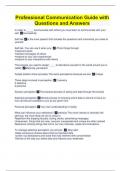Engineering
Mechanics Statics 6e
Anthony Bedford,
Wallace Fowler
(Solu�ons Manual All
Chapters, 100%
Original Verified, A+
Grade)
(Chapter 1-11)
, Chapter 1
Problem 1.1 In 1967, the International Committee Solution: The number of cycles in two seconds is
of Weights and Measures defined one second to be the 2(9,192,631, 770) = 18,385, 263, 540.
time required for 9,192,631,770 cycles of the transition Expressed to four significant digits, this is 18,390, 000, 000 or 1.839E10
cycles.
between two quantum states of the cesium-133 atom.
Express the number of cycles in two seconds to four sig- 18,390,000,000 or 1.839E10 cycles.
nificant digits.
Problem 1.2 The base of natural logarithms is Solution:
e = 2.71828183... . (a) Express e to three significant (a) The rounded-off value is e = 2.72.
digits. (b) Determine the value of e 2 to three significant (b) e 2 = 7.38905610..., so to three significant digits it is e 2 = 7.39.
(c) �Squaring the three-digit number we obtained in part (a) and
digits. (c) Use the value of e you obtained in part (a) to
expressing it to three significant digits, we obtain e 2 = 7.40.
determine the value of e 2 to three significant digits.
(a) e = 2.72. (b) e 2 = 7.39. (c) e 2 = 7.40.
[Comparing the answers of parts (b) and (c) demonstrates
the hazard of using rounded-off values in calculations.]
Problem 1.3 The base of natural logarithms (see Solution:
Problem 1.2) is given by the infinite series The exact value rounded off to five significant digits is e = 2.7183. Let
N be the number of terms summed. We obtain the results
1 1 1
e = 2+ + + +�.
2! 3! 4! N Sum
Its value can be approximated by summing the first few 1 2
terms of the series. How many terms are needed for the 2 2.5
approximate value rounded off to five digits to be equal 3 2.666...
to the exact value rounded off to five digits? 4 2.708333...
5 2.71666...
6 2.7180555...
7 2.7182539...
We see that summing seven terms gives the rounded-off value 2.7183.
Seven.
Problem 1.4 The opening in the soccer goal is 24 ft
wide and 8 ft high, so its area is 24 ft × 8 ft = 192 ft 2 .
What is its area in m 2 to three significant digits?
Solution:
2
A = 192 ft 2 ( 3.281
1m
ft
) = 17.8 m 2
A = 17.8 m 2
Problem 1.4
Problem 1.5 In 2020, teams from China and Nepal, Solution:
based on their independent measurements using GPS (a) The height of the mountain in kilometers to three significant digits is
satellites, determined that the height of Mount Everest is 8848.86 m = 8848.86 m ( 1000
1 km
) = 8.85 km.
8848.86 meters. Determine the height of the mountain m
to three significant digits (a) in kilometers; (b) in miles. (b) Its height in miles to three significant digits is
8848.86 m = 8848.86 m ( 3.281
1m
ft
)( 5280
1 mi
ft
) = 5.50 mi.
(a) 8.85 km. (b) 5.50 mi.
Copyright © 2024, 2008 by Pearson Education, Inc. or its affiliates.
1
BandF_6e_ISM_CH01.indd 1 12/04
, Problem 1.6 The distance D = 6 in (inches). Solution:
The value of M P is
The magnitude of the moment of the force
F = 12 lb (pounds) about point P is defined to be M P = FD
the product M P = FD. What is the value of M P in = (12 lb)(6 in)
N-m (newton-meters)? = 72 lb-in.
Converting units, the value of M P in N-m is
F 72 lb-in = 72 lb-in ( 0.2248
1N
)( 1 m ) = 8.14 N-m.
lb 39.37 in
8.14 N-m.
P
D
Problem 1.6
Problem 1.7 The length of this Boeing 737 is Solution:
Because 1 ft = 12 in, the length in meters is
110 ft 4 in and its wingspan is 117 ft 5 in. Its maxi-
mum takeoff weight is 154,500 lb. Its maximum range is (110 + 124 ft )( 0.3048
1 ft
m
) = 33.6 m.
3365 nautical miles. Express each of these quantities in
SI units to three significant digits. In the same way, the wingspan in meters is
(117 + 125 ft )( 0.3048
1 ft
m
) = 35.8 m.
The weight in newtons is
( 154, 500 ( 4.448
lb )
1 lb
N
) = 687,000 N.
One nautical mile is 1852 meters. Therefore, the range in meters is
(3365 nautical miles) ( 1 nautical
1852 m
mile
) = 6.23E6 m.
Length = 33.6 m, wingspan = 35.8 m,
Problem 1.7 weight = 687 kN, range = 6230 km.
Problem 1.8 The maglev (magnetic levitation) train
from Shanghai to the airport at Pudong reaches a speed of
430 km/h. Determine its speed (a) in mi/h; (b) in ft/s.
Solution:
(a)
v = 430
h
(
km 0.6214 mi
1 km
)
= 267mi/h .
v = 267 mi/h
(b)
v = 430
km 1000 m
h
(
1 km
)( 0.3048
1 ft
)( 1 h )
m 3600 s
= 392 ft/s.
v = 392 ft/s
Source: Courtesy of Qilai Shen/EPA/Shutterstock.
Problem 1.8
Copyright © 2024, 2008 by Pearson Education, Inc. or its affiliates.
2
BandF_6e_ISM_CH01.indd 2 12/04
, Problem 1.9 In the 2006 Winter Olympics, the men’s Solution:
15-km cross-country skiing race was won by Andrus (a)
15 km 60 min
Veerpalu of Estonia in a time of 38 minutes, 1.3 seconds. v =
Determine his average speed (the distance traveled (
38 +
1.3
60
)
min 1 h
divided by the time required) to three significant digits = 23.7 km/h.
(a) in km/h; (b) in mi/h. v = 23.7 km/h
(b)
1 mi
v = (23.7 km/h) = 14.7 mi/h.
1.609 km
v = 14.7 mi/h
Problem 1.10 The Porsche’s engine exerts 229 ft-lb
(foot-pounds) of torque at 4600 rpm. Determine the
value of the torque inN-m (newton-meters).
Solution:
T = 229 ft-lb ( 0.2248
1N
)( 1 m ) = 310 N-m.
lb 3.281 ft
T = 310 N-m
Problem 1.10
Problem 1.11 The kinetic energy of the man in Solution:
Practice Example 1.1 is defined by 12 mv 2, where m
1 slug 2
is his mass and υ is his velocity. The man’s mass is T = 1224 kg-m 2 /s 2 (
1 ft
14.59 kg 0.3048 m )
68 kg and he is moving at 6 m/s, so his kinetic energy
= 903 slug-ft 2 /s.
is 12 (68 kg)(6 m/s) 2 = 1224 kg-m 2 /s 2. What is his
kinetic energy in US customary units? T = 903 slug-ft 2 /s
Problem 1.12 The acceleration due to gravity at sea Solution:
level in SI units is g = 9.81 m/s 2 . By converting units, Use Table 1.2. The result is:
use this value to determine the acceleration due to gravity
at sea level in US customary units.
g = 9.81 ( sm )( 0.3048m
2
1ft
) = 32.185...( sft ) = 32.2( sft ).
2 2
Problem 1.13 The value of the universal gravitational Solution:
constant in SI units is G = 6.67E−11 m 3 /kg-s 2 . Use Converting units,
this value and convert units to determine the value of G 3
in US customary units. 6.67E − 11 m 3 /kg-s 2 = 6.67E − 11 (
m 3 3.281 ft
kg-s 2 1m
)
1 kg
0.0685 slug
= 3.44E − 8 ft 3 /slug-s 2 .
G = 3.44E − 8 ft 3 /slug-s 2
Copyright © 2024, 2008 by Pearson Education, Inc. or its affiliates.
3
BandF_6e_ISM_CH01.indd 3 12/04





